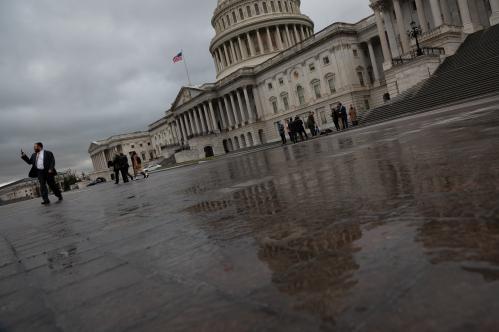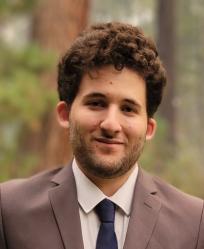In contemporary American politics, talk of secession is rarely more than theater. Political leaders tease—sometimes bellow—the idea as a reaction to unfavorable election results, the prospect of big-ticket legislation with which they disagree, meat for their base, or to attract media attention. In reality, the barriers to secession by any state or region within the United States are exceptionally high.
There are, however, quasi-secessionist political movements that do not threaten the United States’ territorial or political integrity but nonetheless express a growing, elemental discomfort with one of the fundamental principles of a healthy democracy. Though these efforts, like their flashier secession relatives, carry little likelihood of success, the grassroots sentiments underpinning them—in particular, the decay of Americans’ willingness to be governed by their political rivals—render them worthy of analysis for what they communicate about polarization, hyper-partisanship, and political intolerance.
Secession from one state to another
From the Mid-Atlantic to the Pacific Northwest, rural counties in blue states have taken steps to redraw state lines to subsume themselves under neighboring red states or to form new states of their own. In some cases, such exercises have drawn sizeable community support, leading to the placement of the secession question on local ballots and subsequent approval by voters.
The Pacific Northwest is home to a long-running movement to reorganize state lines along political rifts. In Oregon, Washington, and northern California, as in much of the United States, rural counties are much redder than their densely populated, coastal counterparts. Citing dissatisfaction with the liberal policies of the state government, citizens in some rural Oregon counties have organized to place on the ballot the question of whether to break from their home state to join neighboring Idaho—a reliably red state for the past fourteen presidential elections, where Republicans helm every statewide and federal office. In 2021, five of those counties in Oregon forged ahead and voted to join Idaho. Similar votes are likely to be held in the future in rural counties in Washington and northern California.
In the Mid-Atlantic, Republican state lawmakers in heavily Democratic Maryland made overtures in 2021 to the state legislature in West Virginia expressing their desire to secede from their home state. The lawmakers—all representing portions of three counties in Maryland’s rural western panhandle—claimed in their letters that West Virginia, in both its professed values and the heavily Republican lean of its government, would be a better home for their constituents than Maryland, where Democrats enjoy supermajorities in the State House and reclaimed the Governor’s Mansion in November. Residents of the three counties have not yet been asked to weigh in on the switch via a ballot question, though the lawmakers have indicated that such a step could be taken in the future.
This phenomenon is not exclusive to the coasts. Over two dozen counties in Illinois, including four in the southern portion of the state that border ruby-red Kentucky, have taken steps to leave Illinois for redder pastures, including by passing non-binding resolutions that encourage local officials to explore the possibility of leaving the state. Meanwhile, residents of a county in northern Colorado have explored the idea of joining heavily Republican Wyoming. And in 2021, a New Mexico state senator proposed an amendment to the state constitution that would allow counties to pursue secession, either by joining neighboring states or by creating a new one.
Even if voters do approve a state switch via referendum, actually merging with a neighboring state and shifting state borders is an exceedingly arduous procedure. The process, which is similar to that by which new states are admitted to the nation via Article IV, Section 3 of the Constitution, requires approval by both the legislatures of the affected states and by Congress.
Along with those high technical hurdles, states would be hard-pressed to find economic or political incentives to surrender counties to a neighbor or to allow them to form their own states. State legislatures are unlikely to pass off portions of their tax base to other jurisdictions. Ceding population, which helps determine, among other things, a state’s Electoral College votes and its number of congressional districts, is also a political non-starter. Some legal analysts have further argued that Supreme Court precedent renders county-level secession impossible.
What is notable about these movements, then, is not their potential to radically restructure political jurisdictions, but what they telegraph about the deterioration of Americans’ willingness to tolerate life under the rule of the opposing party.
Analyzing county-level secession
Residents who vote for their counties to switch states for political reasons send two messages with their ballots. First, that they are displeased with rule by their political rivals. The second message is less direct but no less consequential for the nation at large: Those voters signal an unwillingness to live in a state where their party does not control the levers of power and therefore does not dictate their state’s policy agenda. Once a cornerstone of democratic life, that toleration’s decay and a drift toward zero-sum thinking about power-sharing in governance bode poorly for the nation’s sociopolitical cohesion.
A sharpening rural-urban divide is a persuasive, though incomplete, explanation for the growth of these movements. The gulf between the two groups in key measures—socioeconomic status, education level, age, and others—has been widening for decades. Values shape what citizens expect of their elected officials and the bodies they comprise, meaning that as rural and urban Americans diverge further in their worldviews, their expectations of their representatives diverge concomitantly. Analysts have also argued that both parties have historically neglected rural populations, exacerbating their dissatisfaction.
What rural voters choose to do in the face of that disconnect (or neglect) is where polarization’s toxic effect becomes clear. For differences in policy priorities across demographics are not new. Americans, as participants in a democracy, have always had to stomach rule by the opposition, whether at the local, state, or federal level. Indeed, the persistence of democracy rests on individuals and parties maintaining a willingness to participate in the democratic system even when their party, their team, loses. Elections have consequences, meaning that when one’s political rivals win an election, conferring on them the prerogative to steer government, they reserve the right to legislate the priorities on which they campaigned.
But as American politics have radicalized, willingness to be in the minority has waned. Americans have become more restive under the rule of the opposition, be it at the state or federal level, increasingly viewing it as insufferable tutelage. In many ways, the impulse to call lost elections “stolen” or “rigged” is an outgrowth of that lack of toleration. The use of increasingly apocalyptic language to describe the election victory of the opposing side epitomizes the dire terms in which Americans have come to view living under the control of their political rivals. The spirit of competition that typifies democracy, specifically the effort to change strategies to attract new voters, to get behind leaders who offer real solutions and express a readiness to work across the aisle to devise solutions to problems afflicting both rural and urban Americans, and to expand one’s representation in government, has been supplanted by a readiness to blow up the system.
Even if that destructive impulse is not new, the impassioned drive toward life in uniformly like-minded political environments is. Indeed, in many ways, those counties seeking to join politically similar states are merely taking the next step toward the ideological homogeneity that has been congealing in the United States for the past several decades, with each party’s vote share growing in counties and states where it already does well. Americans increasingly choose where they live based on the political lean of the area. Polarization can now be tracked in geographical terms.
But there is a strong case to be made that the cross-aisle conversations which arose from that comingling of political ideologies was what once made American democracy so robust, and what now has rendered it so frail. County-level efforts to address political dissatisfaction by simply becoming part of neighboring states with more kindred political leadership only accelerate that self-sorting, further isolating Americans in their increasingly unbreachable ideological silos.
Rather than the louder, more theatrical shouts of secession from political leaders seeking points with the base, grassroots, county-level maneuvers to switch states should disquiet those attempting to peer into the nation’s future. Both exercises—the grand and the humble—bear little chance of success. But the latter figures as a better barometer of local dissatisfaction, a sign that the sociopolitical fabric anchoring American democracy is fraying. Certainly, that fabric has been stressed, stretched, and ripped; but never so irrevocably that it could not be stitched back together. Aside from offering valuable data to campaigns and leaders who seek to mend, not widen, the country’s political divides, these movements offer a window into local thinking about governance and toleration in today’s strained America.
-
Acknowledgements and disclosures
The authors would like to thank Darrell West for his suggestions and comments on an earlier draft of this analysis.







Commentary
County secession: Local efforts to redraw political borders
January 10, 2023